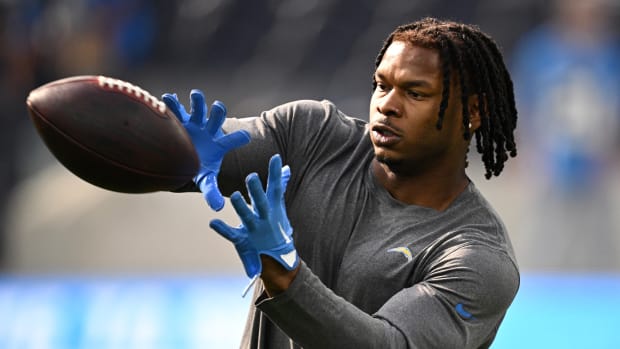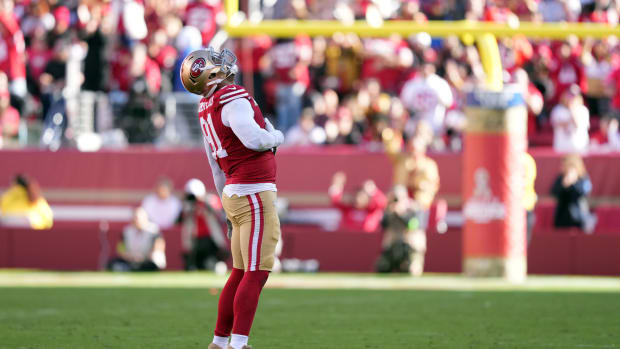A Case Study of the Mondays: Week 1
Eagles offense vs. Redskins defense
Who ever thought Michael Vick wouldn’t be the most hyped mobile quarterback in a season-opening Monday night game? Most are eager to see how Robert Griffin III looks in his first action since having reconstructive knee surgery in January, but Vick will be just as interesting to watch.
Though Philadelphia’s quarterback competition carried on for the better part of August, it was a no-brainer for Kelly to name Vick the starter. He has mobility; Nick Foles does not. Vick has vowed to be a more potent running threat this season, which may explain why Kelly gave Foles so many first-team reps in camp. A running Vick inevitably means an injured Vick. At some point this season the Eagles will likely have to rely on Foles. This will mean tweaking the system. But for now Vick is at full force.
The most important aspect of Kelly’s offense is its fast-break tempo, which will help Vick, an 11th-year veteran who has always struggled with nuances such as making pre-snap reads or recognizing post-snap coverage rotations. An up-tempo offense nullifies a lot of those job requirements. While a no-huddle may seem more complex than the standard offense, it’s actually simpler. When you play fast, there isn’t time for pre-snap adjustments, meaning everything—including the defense—is inherently more basic.
This limits Redskins defensive coordinator Jim Haslett, who is known for aggressive blitzes and highly unconventional hybrid disguises. Much of that could get thrown out the window on Monday night when the Eagles line up and snap the ball with 20 seconds left on the play clock.
By shortening the time between plays, you must also shorten the plays themselves—at least in the passing game. Routes must be quicker and more confined; stretching the field vertically means receivers take longer to get back to the line and be ready for the next snap. Quicker patterns demand quicker decisions from the quarterback. Pulling the trigger early will be Vick’s toughest challenge, and a sign of his discipline and anticipation.
Kelly’s system won’t afford Vick enough time to make the improvised scrambles that produced the majority of his 5,551 career rushing yards. For Vick to be the mobile threat he hopes to be, Kelly will have to call plays that naturally put him on the move. This includes things like rolled pockets, bootlegs and other misdirection concepts. You know, the type of things the Redskins will be doing with RG3.
QB Robert Griffin III and tailback Alfred Morris combined for 2,428 rushing yards as rookies last season.
Redskins offense vs. Eagles defense
It’s been impossible to miss status updates on Robert Griffin III over the past few months, but what about the rest of Washington’s offense? With a solid zone-blocking front five and the powerful, efficient tailback Alfred Morris serving as RG3’s sidekick, the unit produced one of the league’s best rushing attacks last season. Though Morris is not a speedster, he is very effective getting outside the tackles. Such stretch runs and tosses, along with plant-and-go cutbacks, make up the backbone of the zone running game.
A zone-blocking offensive line coach will tell you that it is more difficult for linemen to recognize and execute outside blocking assignments against a 3-4 defensive front than a 4-3. Reason being, a 3-4 outside linebacker aligns off the line and in an upright position, which gives him more immediate movement options than a 4-3 end crouched along the line of scrimmage. The Eagles are breaking in their new 3-4 scheme under defensive coordinator Billy Davis. Given that they only kept three outside linebackers on their roster, Philly’s 3-4 will likely be rich in one-gap (i.e. 4-3) concepts. Still, the presnap alignment of their standup outside backers will command on-the-fly run-blocking adjustments by Washington’s offensive tackles. Trent Williams has more than enough athleticism to handle this on the left side; on the right side, however, heavier-footed sixth-year veteran Tyler Polumbus may need some help from motion backfield blockers and tight ends.
Ultimately, the Redskins may find that running the ball is not the most fruitful way to attack this defense. The Eagles’ secondary is shaky in the middle. Safeties Nate Allen and Kurt Coleman were both overly aggressive as downhill attackers last season, leaving themselves vulnerable to play-action. Newcomer Patrick Chung had similar problems in New England last season. And Earl Wolff, an intriguing fifth-round rookie who will likely garner significant playing time this season, will be adjusting to the speed of his first meaningful NFL game. The Redskins were the most productive play-action team in football last season. Look for them to go heavy with this tactic on Monday night.
Texans offense vs. Chargers defense
Manti Te’o (l.) is sidelined by an injured right foot and will likely be replaced by Bront Bird (r.), a 6-4, 250-pound backer who went undrafted in 2011 and will be making his first NFL start.
With Manti Te’o unable to make his debut because of an injured right foot, the Chargers will likely start Bront Bird at inside linebacker. Given the Texans’ style of play, he'll be an integral factor in the outcome. For such an untested player—undrafted coming out of Texas Tech in 2011, Bird has appeared in 14 games over the past two seasons but never started— there aren’t many tougher opponents to face.
The crux of Gary Kubiak’s offense system is to put linebackers and safeties in a position of uncertainty about whether they’re seeing a run or a pass. Defenders must play with exaggerated patience and be able to immediately recover with a burst of aggression. A misstep means a big play for the offense.
The Texans create uncertainty through their zone-stretch runs and play-action rollouts—two very different plays that look exactly the same for the first few seconds after the snap. The key to this working is having a fundamentally precise, synchronized offensive line. As great as Arian Foster is—he is slated to start after battling a variety of injuries in August—Houston’s ground game doesn’t work without cohesive zone-blocking from the front five.
It’s critical that Bird and fellow inside backer Donald Butler (a highly underrated ball hunter) make plays on first and second down. The way to beat the Texans is to put them in third-and-long, where quarterback Matt Schaub’s limited arm strength cannot be masked by subterfuge and misdirection.
We’ll learn a lot about this Chargers defense by how coordinator John Pagano chooses to play in obvious passing situations. Pagano’s hybrid 3-4 is built to attack on third-and-long, but last season his Chargers often played conservative because he didn’t trust the corners to handle the man coverage assignments that most blitzes demand. The Chargers have a new duo of outside corners this season, with ex-Jaguar Derek Cox likely following opposing No. 1 receivers, and third-year pro Shareece Wright following No. 2s. But new doesn’t necessarily mean better. Cox has been abused by upper-tier No. 1 wideouts in the past (this would include the Texans’ Andre Johnson, who had 273 receiving yards in Week 11 against the Jaguars last year, victimizing Cox for most of them). And Wright was unable to warrant serious snaps last season despite San Diego’s futility at his position. The Texans drafted rookie DeAndre Hopkins in the second round precisely to take full advantage of such iffy secondaries.
Chargers offense vs. Texans defense
Brian Cushing gives the Texans the ability to threaten an A-gap blitz on any given down, which could spell trouble for Philip Rivers.
Ideally, the Chargers would love to break in Mike McCoy’s new offense against a defense that isn’t so adept in man coverage as Houston’s. One of the reasons to run a quick-passing spread system is that it often forces the defense to play man-to-man across the board. Mismatches can be easier to come by, because most defenses don’t have four or five quality press defenders.
The Texans, however, prioritize versatile defenders who can play man-to-man anywhere on the field. They have two excellent outside corners in Kareem Jackson and two-time Pro Bowler Johnathan Joseph (who can also play inside, if needed). They also have two safeties who can play man: former Bears corner Danieal Manning and second-round rookie D.J. Swearinger. Newcomer Ed Reed will be the roving centerfielder, either over the top or underneath, depending on the design of the pass rush and the offensive formation.
With either of these safeties capable of matching up against tight end Antonio Gates (especially if they get a bit of help from jam-defenders off the line or double-teams downfield), and with Malcolm Floyd recently returning from a knee injury, quarterback Philip Rivers’ go-to target in the passing game might be whoever lines up in the slot (Vincent Brown, Eddie Royal and Keenan Allen have the skill-set to be used here). That is the one area where Houston’s coverage could be weak; third-year corner Brandon Harris remains unpolished in his short-area technique.
Running backs must be considered in this equation. Offenses down the stretch last season had a blast using them to attack the backup linebackers that Houston dropped in coverage. The Chargers now have Danny Woodhead, one of the league’s best all-around spread system receiving backs, and because of Ryan Mathews’ unreliability, they retained the big-bodied Ronnie Brown, who is very serviceable as an underneath target out of the backfield.








































